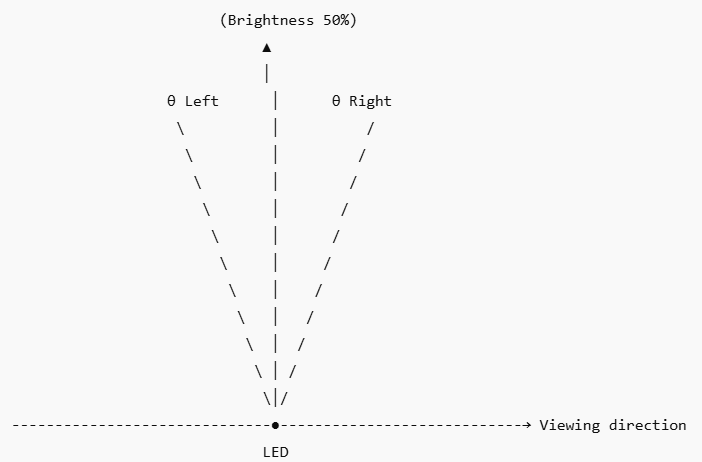20
2025
-
08
Understanding LED Viewing Angle: Why It Matters for Display Performance
Author:
When evaluating LED displays or lighting products, one technical parameter often overlooked is the viewing angle. Yet, it plays a critical role in how clearly and consistently your LED screen or light can be seen in real-world environments.
What Is Viewing Angle?
The viewing angle of an LED refers to the range of directions from which the LED’s brightness can be observed effectively.
At the center (0°): When you look directly at the LED, you see its maximum brightness.
Moving sideways or up/down: As the observer shifts left, right, up, or down, the brightness gradually decreases.
Half-brightness point: Once the brightness drops to 50% of the maximum value, the angle between the center and that point is recorded.
Horizontal & vertical viewing angles: By measuring this drop on both the left and right, or top and bottom, we can calculate the horizontal viewing angle and vertical viewing angle respectively.
In short, the viewing angle = the total angle where brightness remains above 50% of the maximum.

Why Is Viewing Angle Important?
- Uniform Visibility
A wide viewing angle ensures the display looks bright and clear from different positions. This is especially crucial for outdoor traffic signs, billboards, or stadium screens where audiences are spread across wide areas.
- Application Suitability
Narrow viewing angle (e.g., 60°–90°): Better for indicator lights or focused signage where the observer is directly in front.
Wide viewing angle (e.g., 120°–160°): Ideal for large LED displays, transportation systems, and advertising screens.
- Customer Experience
Imagine a highway LED speed display: if the viewing angle is too narrow, drivers outside the direct line of sight may not see the warning in time. With a wide-angle LED, visibility and safety are greatly improved.
How Manufacturers Define It
LED manufacturers typically provide horizontal and vertical viewing angles in their datasheets. For example, a specification might say:
Horizontal Viewing Angle: 140°
Vertical Viewing Angle: 120°
These values indicate the effective brightness zone in which the LED remains clear and readable.
Balancing Brightness and Angle
It’s worth noting that increasing the viewing angle may slightly reduce peak brightness because the light is spread across a wider area. Therefore, choosing the right balance between brightness and viewing angle is critical depending on your project needs.
Traffic safety signs: Require both high brightness (for daylight) and wide angle (for visibility from different lanes).
Indoor displays: Often prioritize wider viewing angles for group viewing, even at the cost of peak brightness.
Conclusion
The viewing angle is not just a number on a datasheet — it directly affects how effectively your LED product communicates information to its audience. Whether you are sourcing LEDs for smart transportation, advertising, or industrial use, always check the viewing angle specification to ensure optimal performance in real-world conditions.
At Chuangdi Technology, we design LED traffic solutions with carefully optimized viewing angles, ensuring maximum safety, clarity, and visibility.
Latest Blog
2025-10-27
Solar Road Studs: Guiding Lights for Safer Journeys
Solar road stud is an active lighting road warning device that utilizes solar energy as its power source.It makes night-time road driving more safe.
2025-10-24
Eco-Friendly Solar Radar Speed Limit Sign
The eco-friendly solar radar speed limit sign represents a significant step towards integrating sustainability into our infrastructure while prioritizing road safety. By harnessing renewable energy, reducing environmental impact, and promoting responsible driving behavior, these signs embody a holistic approach to traffic management.
2025-10-21
Height Limiting Node Integrated Machine | Precise Height Limiting, Automatic Road Closure
The height-limiting node integrated machine has effectively improved the passage efficiency of expressway toll stations and reduced congestion.
